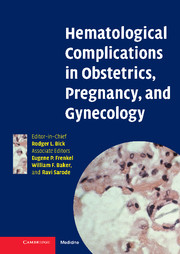Book contents
- Frontmatter
- Contents
- List of contributors
- Preface
- 1 Disseminated intravascular coagulation in obstetrics, pregnancy, and gynecology: Criteria for diagnosis and management
- 2 Recurrent miscarriage syndrome and infertility caused by blood coagulation protein/platelet defects
- 3 Von Willebrand disease and other bleeding disorders in obstetrics
- 4 Hemolytic disease of the fetus and newborn caused by ABO, Rhesus, and other blood group alloantibodies
- 5 Hereditary and acquired thrombophilia in pregnancy
- 6 Thromboprophylaxis and treatment of thrombosis in pregnancy
- 7 Diagnosis of deep vein thrombosis and pulmonary embolism in pregnancy
- 8 Hemorrhagic and thrombotic lesions of the placenta
- 9 Iron deficiency, folate, and vitamin B12 deficiency in pregnancy, obstetrics, and gynecology
- 10 Thrombosis prophylaxis and risk factors for thrombosis in gynecologic oncology
- 11 Low molecular weight heparins in pregnancy
- 12 Post partum hemorrhage: Prevention, diagnosis, and management
- 13 Hemoglobinopathies in pregnancy
- 14 Genetic counseling and prenatal diagnosis
- 15 Thrombocytopenia in pregnancy
- 16 Neonatal immune thrombocytopenias
- 17 The rational use of blood and its components in obstetrical and gynecological bleeding complications
- 18 Heparin-induced thrombocytopenia in pregnancy
- 19 Coagulation defects as a cause for menstrual disorders
- Index
- Plate section
- References
3 - Von Willebrand disease and other bleeding disorders in obstetrics
Published online by Cambridge University Press: 01 February 2010
- Frontmatter
- Contents
- List of contributors
- Preface
- 1 Disseminated intravascular coagulation in obstetrics, pregnancy, and gynecology: Criteria for diagnosis and management
- 2 Recurrent miscarriage syndrome and infertility caused by blood coagulation protein/platelet defects
- 3 Von Willebrand disease and other bleeding disorders in obstetrics
- 4 Hemolytic disease of the fetus and newborn caused by ABO, Rhesus, and other blood group alloantibodies
- 5 Hereditary and acquired thrombophilia in pregnancy
- 6 Thromboprophylaxis and treatment of thrombosis in pregnancy
- 7 Diagnosis of deep vein thrombosis and pulmonary embolism in pregnancy
- 8 Hemorrhagic and thrombotic lesions of the placenta
- 9 Iron deficiency, folate, and vitamin B12 deficiency in pregnancy, obstetrics, and gynecology
- 10 Thrombosis prophylaxis and risk factors for thrombosis in gynecologic oncology
- 11 Low molecular weight heparins in pregnancy
- 12 Post partum hemorrhage: Prevention, diagnosis, and management
- 13 Hemoglobinopathies in pregnancy
- 14 Genetic counseling and prenatal diagnosis
- 15 Thrombocytopenia in pregnancy
- 16 Neonatal immune thrombocytopenias
- 17 The rational use of blood and its components in obstetrical and gynecological bleeding complications
- 18 Heparin-induced thrombocytopenia in pregnancy
- 19 Coagulation defects as a cause for menstrual disorders
- Index
- Plate section
- References
Summary
Introduction
Bleeding disorders in the female population often present unique challenges to an obstetrician. The hormonal and physical changes that occur during the menstrual cycle, pregnancy, childbirth, and the post-partum period continually place strain upon the hemostatic system. Although severe bleeding disorders are usually easily recognized, mild bleeding disorders often go undiagnosed due to the “mild degree” of signs and symptoms (e.g. slightly abnormal menstruation). Unfortunately, even these mild bleeding disorders often lead to a decrease in the quality of life, variable degrees of morbidity, and even life-threatening hemorrhage. Therefore, it is essential that the obstetrician be aware of the clinical clues, appropriate diagnostic tests, and treatment regimens for such disorders. This is particularly important for pregnant women, whose hemostatic system undergoes marked alterations in preparation for the unique challenge of delivery.
The hemostatic system
Basic knowledge of the hemostatic system assists in making clinical decisions regarding bleeding conditions in the obstetric population. Normal hemostasis is a highly regulated, physiologic process of clot formation and clot management that occurs in response to vascular injury. It involves 2 major systems: (i) primary hemostasis and (ii) secondary hemostasis. Although both systems are initiated at the same time and work together intricately to form stable platelet-fibrin clots, the influence that each system has upon clot formation in the arterial versus the venous systems is different.
- Type
- Chapter
- Information
- Publisher: Cambridge University PressPrint publication year: 2006



